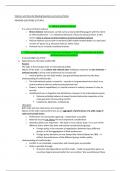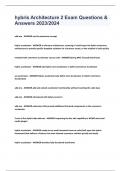Violence and Security Reading Questions and Lecture Notes
READING QUESTIONS LECTURE 1
1. What is political violence?
- It is a form of direct violence
o Direct violence: behaviours carried out by a clearly identifying agent with the intent
to inflict bodily harm – i.e. intentional direction of force for physical harm. In this
course, there is a focus on direct violence in forms of political violence.
o Political violence occurs both in wartime (1000+ battle-related deaths in a year) and
in times of ‘peace’ (e.g. electoral violence, ethnic riots).
o Violence has or is based on political motives
2. What paradigms/approaches have been developed in order to understand and analyse
political violence and conflict?
- 2 key paradigms (a and b):
a. Approaches to interstate conflict (IR)
- Realism
- The state is the principal actor of international politics
- Nature of the state: it is a unitary and rational actor seeking to maximize its own interests +
national security is a first order preference (ie it trumps all)
o Internal politics do not really matter, but guaranteeing national security does.
- Understanding of conflict/order:
o The international system is anarchic – security is not guaranteed since there is no
central authority that can enforce peace/prevent war
o Power (= material capabilities) is a central concern to realism, because it is key to
security
o Likelihood of war is shaped by the distribution of power in the international system
▪ Deterrence/stable balance of power/mutual destruction capacities as the
main guarantor of preventing conflict
▪ Unipolarity, bipolarity, multipolarity
- Liberalism
- Both state and non-state actors are important
- Nature of the state: state preferences are an aggregate of preferences of a wide range of
state and societal actors
o Preferences not necessarily opposing – cooperation is possible
o National security not always the most important consideration
o Domestic politics are important – the state is not a unitary actor; it is a sum of the
different actors within the state and societal constituencies/groups.
▪ Foreign policy is the outcome of negotiations between these different
groups, or of the aggregation of their preferences
▪ Foreign policy decisions are not always fully rational (based on CBA) – it
reflects the preferences of the different groups inside a polity.
- Understanding of conflict/order:
o Conflict is not inevitable; cooperation and mutual gains are possible
o Order is possible through:
▪ Economic interdependence and free trade – trade can guarantee peace as
countries depend economically from one another. War would disrupt those
, economic relations and their gains. Therefore, countries prevent war, also
out of the political consequences that economic downturn might bring.
▪ International institutions – they facilitate information-sharing, transparency
and dialogue, which allows states to ask and give clarification to one another
about policies/acts that might be seen as preparations for war. Moreover,
these institutions also establish rules which, if broke, can lead to sanctions
that prevent countries from entering into war.
▪ Democratic institutions – democratic peace theory / democracies are less
likely to go to war to one another
- Constructivism
- Actors: actors and their interests are socially constructed
- Assumptions about agent behaviour:
o Political action is shaped by identities and interests
o Who the actor is shapes what they view as appropriate action
o Conflict and peace are therefore shaped by the content of identities and interests
(norms), which is why norms are so important to social constructivism.
b. Approaches to intrastate conflict (CP)
- Instrumentalism
- Actors: elites and their interests/behaviour as the primary explanatory variable for the
presence/absence of conflict
- Assumptions of instrumentalism: elites seek to maximize political power and other material
gains and will foment violence to meet their interests – they will foment peace if peace
meets their interests
- Institutionalism
- Approach that seeks to understand how political struggles are mediated by the institutional
setting in which they take place
- Institutions determine the capacity of governments to implement policies such as security
policies that enhance peace
- Institutions also determine the distribution of power along different
political/economic/social groups that may lead to grievances that fuel conflict.
- Constructivism
- Groups as socially constructed and groups are not unitary actors
- Violence as a means of delineating and asserting group boundaries (reflecting their norms)
3. What is the state of violence in the world today?- Pettersson
- The falling trend in fatalities stemming from organized violence in the world, observed for
five consecutive years, broke upwards in 2020 and deaths in organized violence seem to
have settled on a high plateau
- The number of active state-based and non-state conflicts, as well as the number of actors
carrying out one-sided violence against civilians, increased in 2020 when compared to 2019
- there has been a clear regional shift from the Middle East to Africa now driving the trend in
organized violence
- State violence: UCDP documented a record-high number of state-based armed conflicts in
2020, after observing a slowly rising trend for several years.
o In 2019, much of the increase in the number of conflicts was due to IS (Islamic State)
moving into new areas
o Africa drives the growth in the number of active state-based conflicts.
, o In Syria, violence has plummeted since 2013–14, the most violent years of the civil
wars.
o Failing to result in de-escalation, the COVID-19 pandemic was in fact the driving
force behind some conflicts flaring up in 2020
- Non-state violence
o Non-state conflict increased in 2020, in terms of both the number of active conflicts
and the number of deaths incurred in fighting between non-state groups
o The Americas, in particular Mexico, as the centre and main driver of non-state
violence and non-state conflict-related casualties, thereby replacing the Middle East.
- One-sided violence = Africa is the main area of concern and the region that is currently
driving the trend.
o This recent trend can be partly explained by the continuation of the regional shift of
IS from the Middle East to Africa.
o The largest escalation in one-sided violence, however, came from government
actors.
- Syria:
o In the past decade, the multiple conflicts in Syria have driven many of the trends in
organized violence, e.g. fatalities
o Since 2016, the state-based conflicts in Syria have seen a massive decline in fatalities
o Two wars involving the Syrian state: against IS and against Syrian insurgents. The
conflicts in Syria have gone on for a while and are likely to go on for a long time due
to the following factors:
▪ Involvement of international actors supporting non-state actors that
dominate parts of Syrian national territory, e.g. USA and Turkey → provided
these non-state actors with far greater capabilities than would otherwise
have been available to them eg airstrikes
▪ Fragmentation of opposition to Syria’s government → multiparty civil wars
are more difficult to resolve through negotiated settlements
▪ Collapse of state authority in many parts of the country → These areas
ended up under the control of non-state actors, and constituted a base from
which these actors were able to extract resources and manpower to fuel the
conflict against the government.
• This type of warfare changes the risk experienced by civilians in a
conflict setting, with fewer civilians being directly and deliberately
targeted, but more suffering from indiscriminate and indirect
violence.
➔ As such, the collapse of IS in Syria has largely driven the decline in non-state violence in
Syria, though a decline in the global trend was counteracted by the surge in nonstate
violence in Mexico since 2018.
- Most state violence: Africa
o Local conflicts, but also IS moving from Middle East into Africa
- Most non-state violence: Mexico
o Conflicts between competing drug cartels
, LECTURE 1: INTRODUCTION AND OVERVIEW
1. Introduction to the course
- Assessment
o Group assignment – 25%
o Midterm MC exam – 25%
o Final exam – 25%
- Conceptualizing violence
o Johan Galtung 1969: 2 types of violence
▪ Direct violence: behaviours carried out by a clearly identifying agent with
the intent to inflict bodily harm – i.e. intentional direction of force for
physical harm. In this course, there is a focus on direct violence in forms of
political violence.
• Political violence occurs both in wartime (1000+ battle-related
deaths in a year) and in times of ‘peace’ (e.g. electoral violence,
ethnic riots).
▪ Structural violence: violence as present when humans systematically cannot
fulfil their physical and mental potential. Violence does not require intent
and does not require a clear agent. – violence can be psychological, does not
need to be physical, it is more about the structures that shape violence.
“When there are conditions that hamper people’s ability to live good and
healthy lives”. (But it does require physical harm ie inability to live ‘healthy’
lives.)
• E.g. people dying because they cannot access medication (example
of tuberculosis).
- “Peace”
o Johan Galtung, 1969
▪ Negative peace: absence of direct violence
▪ Positive peace: a self-sustaining condition that protects the human security
of a population → conditions are made that ensure peace and prevent
violence.
2. Trends of political violence
- Xi, Putin → May lead to a rise of state-led conflict between states (inter-state wars)
- Leading type of conflicts: intrastate (in a state)
- Amount of non-state conflicts (ie by armed groups that are not states) e.g. IS, cartels→ drop
before (2014-)2019, increase after 2020.
- Fatal violence largely concentrated in Africa, Middle East, Southeast Asia, LATAM.
- What do we mean by paradigms? (Kuhn 1962)
- Paradigms or theoretical frameworks are lenses through which we see/analyze the world
- They contain assumptions about
o The most important actors, as well as their behaviours and motivations
o → What leads to war and violence
o → What allows for peace and security
3. Overview of paradigms and approaches
- 2 key paradigms (a and b):
c. Approaches to interstate conflict (IR)







